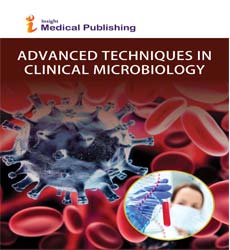Changing Trends in Epidemiology of Candidiasis and Role of Non-Albicans Candida Species
Sachin C Deorukhkar*
Department of Microbiology, Rural Medical College, Loni, Maharastra, India
- Corresponding Author:
- Sachin C Deorukhkar
Assistant Professor
Department of Microbiology
Rural Medical College
Loni, Maharastra, India
Tel: +91-9545181908
Email: deorukhkar.sachin@gmail.com
Received date: November 28, 2016; Accepted date: November 29, 2016; Published date: December 6, 2016
Citation: Deorukhkar SC. Changing Trends in Epidemiology of Candidaisis and Role of Non-Albicans Candida Species. Adv Tech Clin Microbiol. 2016, 1:1.
Copyright: © 2016 Deorukhkar SC. This is an open-access article distributed under the terms of the Creative Commons Attribution License, which permits unrestricted use, distribution, and reproduction in any medium, provided the original author and source are credited.
Introduction
In recent years, the increased incidence of mycosis in general and candidiasis in particular is reported in various studies. Among various mycotic infections, candidiasis has greatest effect due to its frequency and the severity of its complications. Candida spp. can elicit infections in immunocompetent as well as immunocompromised individuals but the incidence of candidiasis is more in immunocompromised hosts. Therefore candidiasis can be rightly called as “disease of diseased”.
Superficial and mucocutaneous candidiasis is extremely common and can occur in otherwise healthy individuals. These infections are quite specific, usually self-limiting in immunocompetent hosts and easy to treat with basic hygiene measures and local treatment. In case of immunocompromised individuals, mucocutaneous candidiasis should be given a special attention as these infections could become a gateway to systemic spread. Superficial candidiasis is characteristically chronic and recurrent and at times, may be the indication of beginning of severe forms of this fungal infection [1].
Candidiasis, especially oropharyngeal candidiasis (OPC) is the most common opportunistic fungal infection among people living with HIV/AIDS (PLHA). It develops in 80-90% of HIV infected patients at some point during progression of their disease. At many times it may be the 1st visible sign of HIV infection and the patient’s only chief complaint [2]. Therefore, it can be rightly said, “Candida is a better physician, as it can discover abnormalities in person’s immune system much sooner, than we with our diagnostic tests”. Although, the incidence of OPC in PLHA has decreased dramatically with the introduction of high active antiretroviral therapy (HAART), it is being still reported from many poor and developing countries. Episodes of OPC are also seen in HAART treated HIV infected patients with low CD4+ cell counts [3].
VVC is among the common clinical condition in women seeking gynecological care; approximately about 75% of women experience at least one episode of VVC. It is has been now excluded from the list of sexually transmitted infections.
Disseminated candidiasis (DC) is a devastating disease associated with high morbidity and mortality rates in both immunocompetent and immunosuppressed critically ill patients [4]. Only a decade back, DC used to be a rare infection restricted to burn and patients with severe trauma. In recent years, the increasing population of patients in need of chemotherapy, organ transplants and intensive care has increased the incidence of DC.
Candida is now considered as the fourth leading cause of health care associated or nosocomial blood stream infection and the number three cause of blood stream infections in the ICUs [4]. It is the third leading cause of central-line associated bloodstream infections and the second leading cause of catheter-associated urinary tract infections in the US [4].
Although C. albicans used to be the predominant isolated species from various clinical specimens, recently published research highlights an increase of NAC spp., such as, C. tropicalis, C. glabrata, C. krusei, C. parapsilosis and C. dubliniensis [4].
The drastic epidemiological shift in trend of candidiasis from C. albicans to NAC spp. can be related to widespread empirical use of azole group of antifungal agent for prophylaxis and treatment of mycoses and utilization of commercially available diagnostic kits for identification of pathogenic fungi. The shift towards NAC spp. is of concern because, the Candida isolates belonging to this group often demonstrate innate or acquired or both reduced susceptibility to fluconazole, the most cost-effective and readily available antifungal drug for treatment of candidiasis.
The specific epidemiology pertaining to the incidence of Candida infections and distribution of Candida spp. (C. albicans versus NAC spp.) varies from region to region, country to country and even as per health-care setup and patient cohorts within the country. Therefore species identification plays an important role in understanding the epidemiology of candidiasis in a particular health-care setup. The changing trends of candidiasis underscore the need of continuous monitoring of species distribution and antifungal susceptibility profile for effective prophylaxis and treatment.
References
- Lopez-Martinez R (2010) Candidosis, a new challenge. Clin Dermatol 28: 178-184.
- Deorukhkar SC, Saini S (2015) Candidiasis: Past, present and future. Int J Infect Trop Dis 2: 12-24.
- De Repentigny L, Lewandowski D, Jolicoeur P (2004) Immunopathogenesis of oropharyngeal candidiasis in human immunodeficiency virus infection. Clin Microbiol Rev 17: 729-759.
- Lokhart S (2014) Current epidemiology of Candida infection. Clin Microbiol Newsl 36: 131-36.
Open Access Journals
- Aquaculture & Veterinary Science
- Chemistry & Chemical Sciences
- Clinical Sciences
- Engineering
- General Science
- Genetics & Molecular Biology
- Health Care & Nursing
- Immunology & Microbiology
- Materials Science
- Mathematics & Physics
- Medical Sciences
- Neurology & Psychiatry
- Oncology & Cancer Science
- Pharmaceutical Sciences
